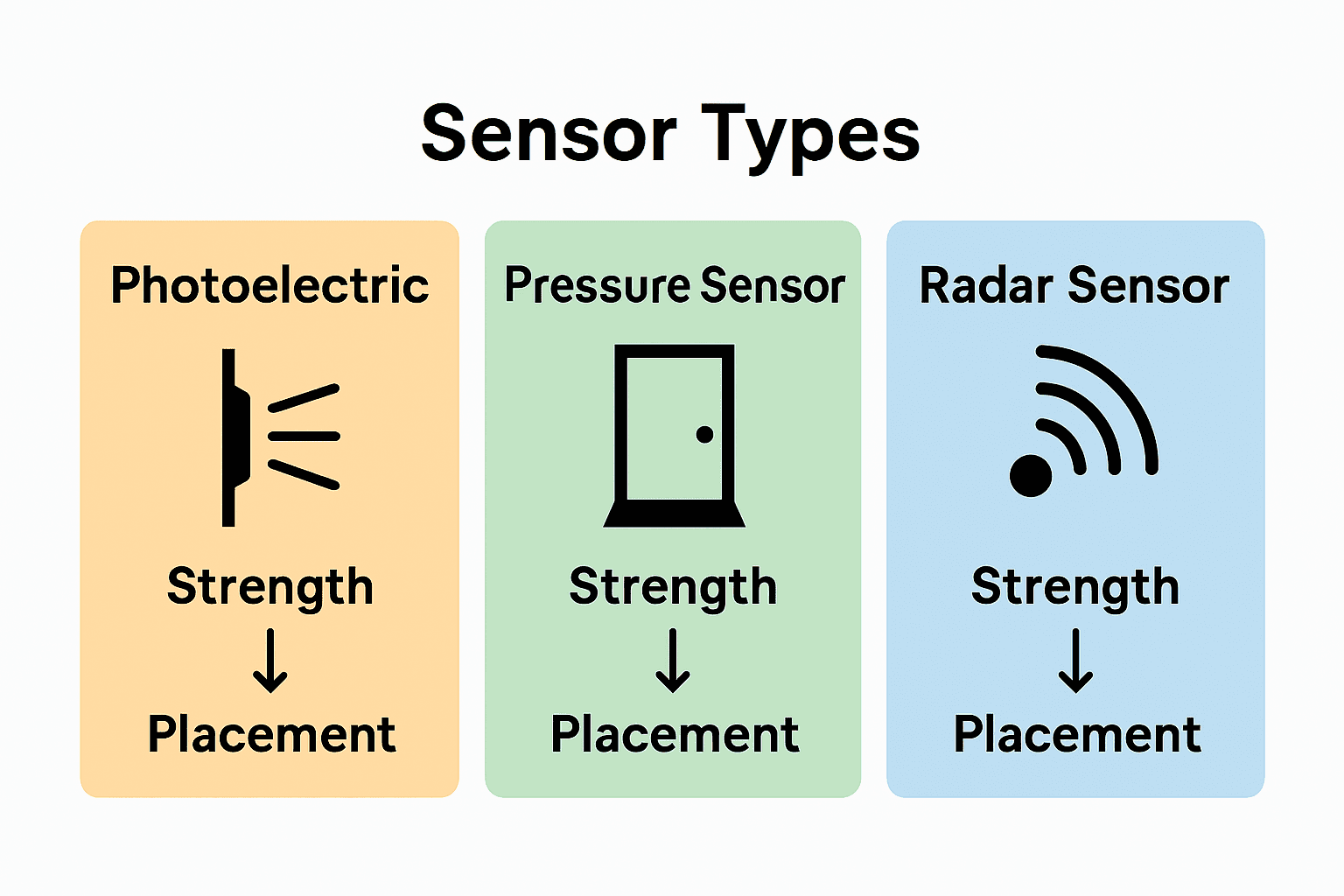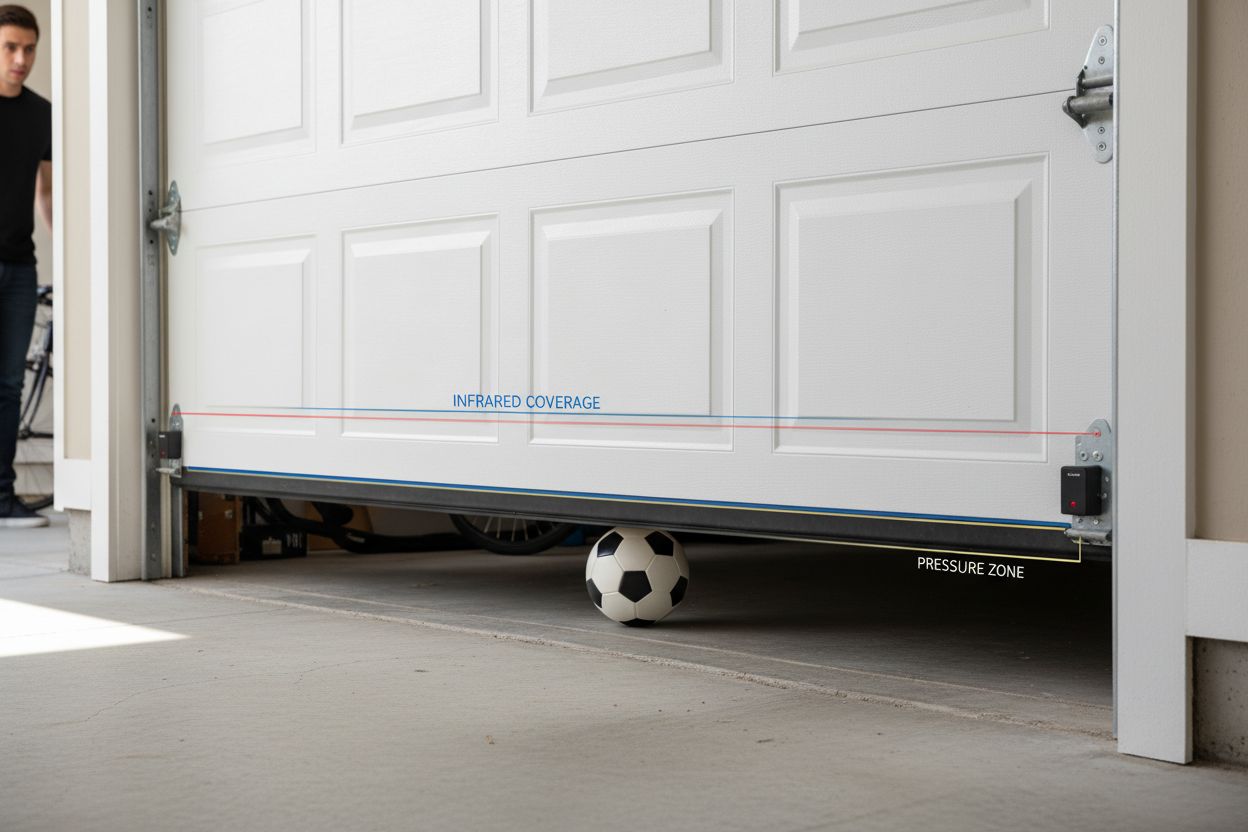Did you know that garage door accidents send thousands of people to the emergency room each year? Mandatory safety sensors have cut these injuries dramatically since 1993, protecting families and their pets every single day. Knowing how these small devices work can help you prevent costly mistakes and keep your garage door running safely. Understanding the types, functions, and rules around garage door safety sensors helps you avoid hazards while meeting local safety standards.
Table of Contents
- Garage Door Safety Sensors Explained
- Different Types of Safety Sensors
- How Garage Door Sensors Operate
- Legal Requirements and Seattle Regulations
- Troubleshooting and Common Sensor Issues
Key Takeaways
| Point | Details |
|---|---|
| Safety Sensor Functionality | Garage door safety sensors, or photo eyes, prevent accidents by stopping and reversing the door when an obstruction interrupts their infrared beam. |
| Types of Sensors | The three main types of garage door sensors – photoelectric, pressure, and radar – each offer unique advantages for obstacle detection. |
| Legal Compliance | In Seattle, garage doors must comply with specific regulations, including mandatory safety sensor installation and regular inspections to avoid penalties. |
| Common Issues and Solutions | Misalignment, lens obstructions, and connectivity problems are common sensor issues; regular maintenance can help maintain optimal performance. |
Garage Door Safety Sensors Explained
Garage door safety sensors are small but mighty devices that play a crucial role in preventing accidents and protecting lives. Photo eyes, as they are technically called, represent a fundamental safety mechanism installed on modern garage door systems. According to research from understanding garage door safety features, these sensors became mandatory in 1993 under UL 325 safety standards, dramatically reducing potential injury risks.
These sensors work through a simple yet ingenious mechanism. Two sensor units are typically mounted on opposite sides of the garage door opening, about 4-6 inches above ground level. They continuously create an invisible infrared light beam between them. When anything interrupts this beam – whether it’s a person, pet, vehicle, or object – the sensors immediately trigger the garage door opener to stop and reverse direction, preventing potential crushing accidents.
Key characteristics of modern garage door safety sensors include:
- Instant detection and response within milliseconds
- Ability to sense objects as small as a child or pet
- Battery-powered or hardwired electrical connections
- Automatic reset after obstruction removal
If you’re experiencing sensor issues, our fix garage door sensor problems guide provides comprehensive troubleshooting steps to help you maintain optimal safety and functionality.
Different Types of Safety Sensors
Garage door safety systems employ multiple sensor technologies to ensure comprehensive protection. According to research from native garage sources, three primary sensor types dominate the market: photoelectric sensors, pressure sensors, and radar sensors. Each type offers unique detection capabilities designed to prevent potential accidents and enhance overall garage door safety.
Here’s a comparison of the main garage door safety sensor types:

| Sensor Type | Detection Method | Typical Placement | Key Benefit |
|---|---|---|---|
| Photoelectric | Infrared light beam | 4-6 in. above floor | Stops before contact |
| Pressure | Physical resistance | Bottom door edge | Catches direct obstructions |
| Radar | Radio wave motion | Above or side zone | Detects wider area/movement |
Photoelectric sensors are the most common type, utilizing an invisible infrared beam to detect obstacles. When something interrupts the beam, the sensor immediately signals the garage door to stop or reverse. These sensors are particularly effective at detecting objects, people, or pets in the door’s path before physical contact occurs.
Pressure sensors work differently by detecting physical resistance when the garage door encounters an object during closure. If the door makes contact with an unexpected obstruction, these sensors trigger an immediate reversal. This technology provides a secondary layer of protection, especially in situations where the infrared beam might not catch smaller or low-lying objects.
The third sensor type, radar sensors, uses radio wave technology to monitor motion and detect potential obstructions. These advanced sensors can create a more comprehensive detection zone, offering enhanced safety features beyond traditional infrared and pressure-based systems.
 By utilizing radio waves, they can detect movement in a broader area around the garage door.
By utilizing radio waves, they can detect movement in a broader area around the garage door.
When selecting safety sensors, homeowners should consider factors like:
- Detection range
- Response time
- Compatibility with existing garage door systems
- Environmental conditions
For specific guidance on sensor installation and maintenance, our understanding garage door safety features guide provides comprehensive insights to help you make informed decisions about your garage door safety.
How Garage Door Sensors Operate
Garage door safety sensors are sophisticated devices that work through a precise and reliable mechanism of infrared detection. According to research from understanding garage door terminology, these sensors create an invisible protective barrier that monitors the garage door’s pathway during operation. The core functionality involves two sensor units strategically positioned on opposite sides of the garage door opening, typically 4-6 inches above ground level.
The operational principle is straightforward yet ingenious. These sensors continuously emit an invisible infrared light beam between the two units. When any object – whether it’s a person, pet, bicycle, or tool – interrupts this beam, the sensor immediately triggers a safety response. As documented by garage safety research, this interruption instantly signals the garage door opener to stop closing and reverse direction, preventing potential crushing accidents or injuries.
Key operational characteristics of garage door sensors include:
- Millisecond-level detection speed
- Ability to sense objects as small as 2-3 inches tall
- Continuous monitoring during door movement
- Automatic reset after obstruction removal
If you’re experiencing challenges understanding why your garage door might not be responding correctly to sensor inputs, our understanding why garage door won’t close guide provides comprehensive troubleshooting insights to help you diagnose and resolve potential sensor-related issues.
Legal Requirements and Seattle Regulations
Garage door safety regulations in Seattle are stringent and designed to protect residents from potential accidents. Understanding local garage door regulations reveals that the Seattle Building Code mandates specific safety standards for all residential and commercial garage door installations. These regulations are not optional suggestions, but legally enforced requirements that ensure the safety of homeowners and their families.
The primary focus of these regulations centers on mandatory safety sensor installations. Every garage door in Seattle must be equipped with functional safety sensors that can detect and prevent potential crushing hazards. These sensors must be positioned correctly – typically 4-6 inches above ground level – and capable of instantly stopping and reversing the door when an obstruction is detected. Failure to comply with these regulations can result in fines, potential liability issues, and mandatory retrofitting.
Key legal requirements for garage door safety in Seattle include:
- Mandatory installation of photo-eye safety sensors
- Sensors must create an uninterrupted infrared detection zone
- Annual professional inspection recommended
- Immediate replacement of non-functioning sensors
- Compliance with UL 325 safety manufacturing standards
Homeowners in King County looking to understand the most current code requirements can reference our comprehensive garage door code requirements guide, which provides up-to-date information on local safety regulations and installation standards.
Troubleshooting and Common Sensor Issues
Garage door safety sensors are sophisticated devices that can occasionally experience performance issues. According to research from fix garage door sensor problems guide, the most common challenges homeowners encounter involve sensor misalignment, lens obstruction, and electrical connectivity problems. Understanding these potential issues can help you quickly diagnose and resolve sensor-related complications.
Misalignment is the most frequent sensor problem. The two sensor units must be precisely positioned and perfectly aligned to create an uninterrupted infrared beam. Even a slight deviation of less than a quarter-inch can prevent the sensors from functioning correctly. Visual indicators of misalignment include blinking lights on the sensor units or the garage door refusing to close when no visible obstructions are present.
Key troubleshooting steps for garage door sensors include:
- Check sensor alignment using a level
- Clean sensor lenses with a soft, dry cloth
- Verify electrical connections are secure
- Replace batteries in wireless sensor units
- Inspect wiring for any visible damage
If you’re experiencing persistent sensor issues that these basic troubleshooting steps don’t resolve, our understanding why garage door won’t close guide provides additional in-depth diagnostic strategies to help you identify and address complex sensor problems.
Ensure Your Garage Door Safety Sensors Work Perfectly with Summit Garage Doors
If you want to protect your family and property from accidents caused by faulty garage door sensors, you need reliable service you can trust. Issues like sensor misalignment or electrical problems can cause your garage door to stop working properly and create safety risks. At Summit Garage Doors, we understand how critical properly functioning photoelectric and pressure sensors are to your peace of mind. We offer expert repairs and installations designed to keep your garage door safety features running smoothly and in compliance with Seattle regulations.

Don’t wait until a minor sensor glitch becomes a major hazard. Visit Summit Garage Doors now to schedule your professional sensor inspection or repair. Learn more about how we handle sensor problems by checking the Fix Garage Door Sensor Problems Guide and ensure your garage door meets all local safety standards by reviewing the Garage Door Code Requirements for Seattle and King County. Protect your home with expert care today.
Frequently Asked Questions
What are garage door safety sensors and how do they work?
Garage door safety sensors, also known as photo eyes, are devices installed on garage door systems to prevent accidents. They utilize an invisible infrared light beam between two units. When an object interrupts this beam, the sensors trigger the garage door opener to stop and reverse, preventing potential accidents.
What types of safety sensors are available for garage doors?
The three main types of garage door safety sensors are photoelectric sensors, pressure sensors, and radar sensors. Photoelectric sensors use infrared beams to detect obstructions, pressure sensors detect physical resistance, and radar sensors use radio waves to monitor motion and detect potential obstacles.
How can I troubleshoot garage door sensor issues?
Common troubleshooting steps for garage door sensor issues include checking the alignment of the sensors, cleaning the sensor lenses, verifying electrical connections, replacing batteries in wireless units, and inspecting the wiring for damage. Misalignment is often the main issue that prevents sensors from working correctly.
Why are garage door safety sensors required by law?
Garage door safety sensors are required by law to protect individuals from potential crushing injuries. Regulations mandate that every garage door must have functional safety sensors that can detect obstructions and prompt the door to stop and reverse, ensuring a safer environment for users.
Recommended
- Understanding Garage Door Safety Features for Homeowners – Summit Garage Doors | Seattle’s #1 Garage Door Repair & Installation
- Award-Winning Commercial Garage Door Installers in Seattle
- Expert Seattle Garage Door Installation & Repair
- Fix Garage Door Sensor Problems: Step-by-Step Guide – Summit Garage Doors | Seattle’s #1 Garage Door Repair & Installation
